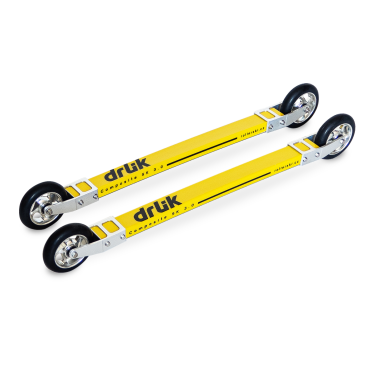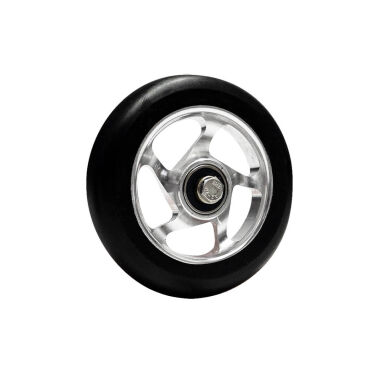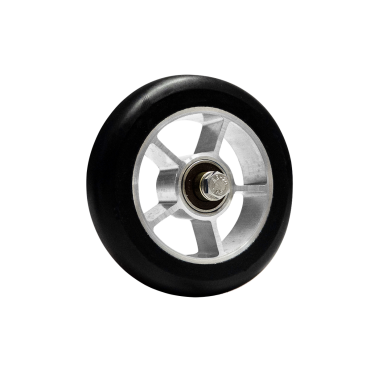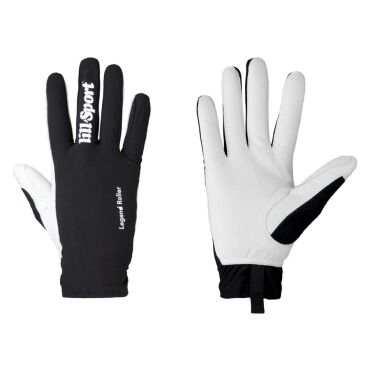How to choose roller skis
Unfortunately, it is not possible to make fully universal skis, so it is necessary to decide whether to choose classic or skating. Both styles have their pluses and minuses, so it is advisable to think carefully about the purchase. It's best to rent and try both types of skis before buying to find out what suits you better.
However, if we were to sum it up in a nutshell, on classic skis you will mainly be riding a combination, as most of the cycle paths are flat and it is not very good to ride a diagonal stride for a long time on the flat. The steeper the hill, the more comfortable and fun the diagonal stride is, so classic skis are ideal for climbing long, difficult hills. On the hill, however, there is the question of how to get down. The advantage of classic roller skis is undoubtedly that you will not get in the way as much as in the case of skating. In short, you take up approximately the same amount of space as cyclists, so you can also go on some less frequented roads, that is, of course, once you have sufficiently mastered the basics of riding roller skis.
The biggest disadvantage of skating skis follows from the above. When skating, you take up as much space as a car, so in Czech conditions it is more or less unthinkable to drive straight down the road. On the other hand, many people consider roller skating to be more "action " and more fun than classics. Skating is also more physically demanding.
What model of classic skis should I choose?

CLASSIC ALU 1.0
Aluminum roller skis, which stand out above all for their durability and stability. This is a model of skis suitable especially for beginner skiers. Beginner skiers will especially appreciate the very good stability and controllability. Another advantage is the resistance of the skis to rough handling.

CLASSIC COMPOSITE 3.0
Roller skis with a flexible composite frame made with similar technology to cross-country skis. These roller skis provide a similar feeling when rebounding as on winter skis, high comfort and excellent vibration damping on a lower quality surface. A wheel with an anti-reverse mechanism is located at the front. Rider weight limit is 90 kg.

CLASSIC CARBON 1.0
Roller skis with a carbon frame that provide similar riding comfort as Classic Composite skis. In addition, however, the Carbon model offers a lower weight, by exactly 200g compared to the Composit model! Thanks to the lower weight, this model is even more similar to classic cross-country skis. Therefore, the lower weight of the skis will be especially appreciated by competitors who deal with every gram of their equipment. This model of skis also has an anti-reversal mechanism at the back, so that an even stronger rebound is achieved. Classic Carbon skis do not have a plastic protector for the underside of the ski to keep the weight low! It is therefore always necessary to carefully overcome all terrain obstacles, so that the underside of the ski does not rub unnecessarily.
Choose roller skis for the classics
What model of skating skis should I choose?

SKATE ALU 1.0
Aluminum roller skis that stand out above all for their durability, light weight and agility. This is a model of skis suitable especially for beginner skiers or heavier skiers weighing over 90 kg. Beginner skiers will especially appreciate the low weight and very good maneuverability. Another advantage is the resistance of the skis to rough handling. Heavier skiers will appreciate the load capacity of the skis up to 110 Kg!

SKATE ALU 2.0
As with the Alu 1.0 variant, these are very durable aluminum skis that can handle even heavier skiers (ski load capacity up to 110 kg). The main difference between these two models is the length of their frames. The Alu 1.0 ski model is 535 mm long, while the 2.0 model is 620mm long. Longer skis are a bit heavier and less agile, but their driving characteristics are more similar to cross-country skis. It is therefore a suitable option especially for those who want to devote more time to developing the correct technique on roller skis.

SKATE ALU 2.0 Short
Compared to the original model (Drlik Skate Alu 2.0), these skis have a 6 cm shorter frame. So they represent a certain compromise between the Alu 1.0 and Alu 2.0 models, which is suitable for complete beginners as well as experienced skiers. Thanks to the shorter frame, the skis are lighter and easier to control, which is especially appreciated by beginner skiers. However, these are still very durable aluminum roller skis that can easily carry even heavier skiers.

SKATE COMPOSITE 3.0
Roller skis with a flexible composite frame, made with similar technology as cross-country skis. For greater stability, these skis also have a reduced frame. Skate Composite 3.0 roller skis provide a similar feeling when rebounding as on winter skis, high comfort and excellent vibration damping on a lower quality surface. This mode of skis therefore provides higher riding comfort than the Skate Alu 3.0 skis, but this is compensated by their higher weight. Rider weight limit is 90 kg.
How to choose wheels?
Classic wheels

Classic Composite
Our roller skis come with Classic Composite - MEDIUM wheels as standard, which correspond to normal winter conditions here and can be considered an ideal choice for both beginners and advanced skiers. However, if you prefer a fast ride, choose FAST wheels, which are approximately 10% faster. On the contrary, if you prefer to make your training a little more difficult, then choose the SLOW wheels, which are approximately 10% slower than the MEDIUM variant.
skating wheels

RC 100
There are medium speed basic wheels with which Drlik Skate Composite 3.0 or Drlik Skate Alu 2.0 skis are delivered as standard. It is one of the fastest in its category. The wheels are especially suitable for beginner skiers who have not yet driven "large portions" of kilometers.

RS 100
we offer three speeds, namely fast (FAST), medium (MEDIUM) and slow (SLOW). The best-selling wheels are MEDIUM, but compared to the RC 100 wheels, they are noticeably slower. The RS 100 series offers the possibility to combine several wheel speeds, which allows you to adjust the speed of the skis exactly according to your wishes. The RS 100 wheels are suitable for more experienced skiers who will appreciate the significantly better durability of these wheels (compared to the RC 100) or the option of choosing slower wheels.

ELITE
we also offer wheels in FAST, MEDIUM and SLOW speeds. However, the ELITE Medium wheels are a bit slower than the RS 100 Medium wheels. Again, the ELITE range of wheels also allows you to combine multiple speeds. In addition, the ELITE series mainly offers, thanks to the higher layer of "rubber", better damping of vibrations arising during driving. In addition, this series of wheels offers even better durability and grip on wet asphalt. Bearing replacement is also easier than in the case of the RS 100 series, thanks to the plastic center.
How to choose equipment for roller skis
equipment for roller skis

Poles for roller ski
Cross-country poles are commonly used on roller skis, but they are need to replace winter baskets with summer tips. There are also poles that are referred to as roller skis, but in terms of construction, they are identical to winter ones. As a rule, the only difference is that rollerski tips are already installed on the asphalt.

Shoes for roller ski
You can use cross-country shoes, but you need to take into account that you will be warm enough in the shoes on hot summer days. In addition, the boots get more use on roller skis. So, if you plan to ride longer routes on a regular basis, it is definitely worth considering whether not to buy special summer boots for roller skis, which are not insulated and ventilate pleasantly while riding

Bindings for roller ski
For roller skis, you can use any binding that is mounted directly in the ski, i.e. not on the mounting plate, such as NIS, IFP or others. We can recommend, for example, the Rottefella RollerSki binding, which was created directly for use on roller skis.

Protective equipment
When riding roller skis, a bicycle HELMET should be a matter of course, it is definitely not a shame. On the contrary, all professionals and experienced "skiers" ride exclusively with a helmet. For beginners, we recommend knee and elbow protectors. For these purposes, "soft" protectors used, for example, for volleyball or handball, which do not restrict movement as much as "hard" protectors used, for example, for inline skating, are more suitable. We also recommend high-quality sunglasses, which you will appreciate not only when going downhill, but also against small insects and dust. An integral part of your equipment should also be special summer gloves with long fingers, which will protect you from unpleasant scrapes in the event of a fall.
FAQs
We recommend always using only adhesives intended for these purposes or thermoplastic adhesives. Be sure to avoid using high-strength adhesives such as two-component, epoxy, etc.
- We heat the glue with a hot air gun, a lighter or over a candle.
- Apply the heated glue to the sticks in a thin layer.
- Heat the glue again, but this time it has already been applied to the poles.
- Place a rollerski tip on the heated glue.
- We check whether the poles are the same length. If not, heat the tip and flatten to the same length.
- We wait at least 5 minutes before we start using the poles.
You don't have to worry, the exchange itself is very simple and you can do it even in "home" conditions. However, if you are still fumbling, visit one of the cross-country equipment sellers who will be happy to help you with the exchange.
The length of poles used on roller skis is approximately the same as the length of poles used on cross-country skis, i.e. for classics it should be approximately 84% of body height and for skating approximately 90%.
However, if you plan to buy poles only for roller skis, then you can choose 2-3 cm longer poles than you use on cross-country skis.
The main reason why poles/rollerski tips slide on asphalt is because they are blunt. Especially the tips on winter baskets, which are not hardened on cheaper poles, can wear off quickly.Tips on winter cups are more prone to breaking off. It is therefore always better to use tips designed specifically for roller skis. They do not have a basket and are resistant to abrasion.
In addition to the tips themselves, technology and air temperature also play an important role, which affects the hardness of the asphalt.
Yes, a diamond file is most often used for sharpening tips. Sharpening itself is a rather lengthy process, and therefore it is not advisable to delay it too much. It is therefore ideal to sharpen the rollerski tips approximately every 50-100 km. You will be sharpening completely round tips for an eternity, and even the final design will definitely not be ideal.
There are several ways to brake on roller skis, but apparently the simplest and most effective way is plowing, which is particularly effective on roller skis designed for classics. The other methods are more demanding in terms of implementation and therefore less suitable for beginners. In addition, most people know plowing at least from downhill skiing.
In the video you can clearly see some of the possible methods of braking
https://www.youtube.com/watch?v=MgfRAhkx75k&feature=emb_imp_woyt
Maintenance of roller skis is very easy. After each ride in the wet, the skis need to be rinsed/showered with clean water and then allowed to dry thoroughly. After that, you can still treat the bearing area (between the fork and the wheel) with Teflon spray. In addition, it is also necessary to change skis regularly (e.g. always in the middle of training), so that your wheels wear evenly and not asymmetrically. Once in a while it is also advisable to check the tightness of all the screws on the roller skis.
The Drlík brand is named after its founder - Ing. Emil Drlík, who started developing and manufacturing roller skis in Jeseník in the 1990s. The brand is thus named after its founder. More in the section Our story
These are roller skis with a long history, which are tested not only by time, but also by a number of domestic and foreign ski clubs. Drlik brand products are currently synonymous with quality products at a friendly price offering great variability. With us, you can immediately choose the wheels that really suit you. We have a wealth of experience with roller skis, which I would be happy to share and advise you on the choice. You can also rely on quality post-warranty service. We keep spare parts in stock for at least 7 years for all ski models.
The smoother the asphalt, the more comfortable it will be to ride on roller skis. However, roller skis can also be used on relatively rough asphalt, but the ride itself will not be as comfortable. The problem is primarily holes in the asphalt, into which a wheel could fit.
Quality carbon poles (at least 60% carbon) are certainly more suitable, as they don't bend as much when riding, so the knocking of the poles is more efficient. On the other hand, carbon poles are relatively fragile, so you need to be a little careful, at least in the beginning.
It is not possible to say unequivocally whether the front or back placement is better, as it is more a matter of personal preference. In simple terms, however, it can be said that for non-racing purposes, the front position is more suitable. You can find more detailed information on this issue here.
The direction of travel on classic roller skis can be easily corrected by hitting the screw holding the wheel with a hammer.
- First of all, you need to find out which way your skis turn. Send the ski down a flat surface and watch which way it turns. Be careful, the ski rarely goes perfectly straight. Therefore, correct the direction of travel only if the ski turns strongly to one side.
- Skis turn to the right: hit the left rear bolt three times lightly with the hammer. The blow should be directed towards the center of the frame, almost perpendicular to the axis of the wheel. If it doesn't help and the ski still turns, then perform a front correction. Hit the left front bolt again three times in the same way. Be careful not to damage the fork holding the wheel.


- Skis turn to the left: hit the right rear bolt three times lightly with the hammer. The blow should be directed towards the center of the frame, almost perpendicular to the axis of the wheel. If it doesn't help and the ski still turns, then perform a front correction. Hit the right front bolt three times again in the same way. Be careful not to damage the fork holding the wheel.


You can repeat the entire correction procedure, so there is no need for very strong strokes. You will avoid possible damage to the fork holding the wheel.